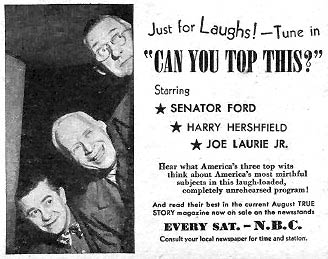Can You Top This?

Can You Top This? was a radio panel game in which comedians told jokes and tried to top one another. The unrehearsed program, sponsored at one point by Colgate-Palmolive, was created by veteran vaudevillian "Senator" Edward Hastings Ford, who claimed he was taking part in a joke session at a New York theatrical club when he conceived the idea. However, the format was quite similar to a prior joke-telling radio series, Stop Me If You've Heard This One (1939–40), which featured Ford and cartoonist Harry Hershfield as panelists. Many jokes involved ethnic humor told in dialect.
Listeners were invited to send in jokes of their own, and an average of 3,000 were submitted per week. Host Peter Donald told the best of these jokes, each one centered on a different topic, while a "laugh meter" took note of the audience reaction on a scale of 0 to 1,000. The "Knights of the Clown Table" – Ford, Hershfield and Joe Laurie Jr. – attempted to top listeners with their own jokes, which sometimes presented an extra challenge as their jokes had to be pertinent to the topic.
A listener whose joke was read on the program received $10, plus a $5 bonus for each panelist who failed to outscore it with his own joke, for a potential maximum prize of $25. Any ties on the laugh meter between a listener and panelist were broken in the listener's favor. Any submitted joke that earned a perfect 1,000 on the laugh meter was thus guaranteed to win the full $25 for its submitter. Every listener whose joke was used received a phonograph recording of Donald telling it on the air. The panelists claimed that together they knew over 15,000 jokes.
Can You Top This? debuted on New York's WOR radio in 1940. NBC picked up the show in 1942, and it continued 12 more years. Hosts at one time or another included Peter Donald, Ward Wilson, Roger Bower and Dennis James.[1]
Television[]
Can You Top This? made its first television debut on ABC on October 3, 1950 but only lasted until March 26, 1951. This version featured Ward Wilson as host and Ford, Hershfield, and Laurie as panelists.
The show was briefly revived in syndication by Four Star Television on January 26, 1970 with Wink Martindale as host and featured Morey Amsterdam as Executive Producer and a regular panelist, but this incarnation lasted just eight months. In this version, one celebrity (such as Dick Gautier, Louie Nye and Richard Dawson) reads jokes submitted by viewers, while a group of panelists (such as Amsterdam, Red Buttons, Paul Winchell and Jack Carter) try to top the viewer's jokes with their own version on the same subject. The viewer would earn $25 for having the joke read by the guest, an additional $25 for each panelist that was unable to top the viewer's joke, and $100 and a nice prize (such as an Ampex audio cassette player) if he/she topped all three panelists.[2] The 1970 version was recorded at CBS Television City in Hollywood, California. Studios 31, 33, 41 and 43 were used at different times making it one of the few game shows to tape in all four studios at CBS.[3]
Episode status[]
At least 36 episodes exist of the radio show,[4] two of which can be heard below. Nine episodes exist of the 1970 version; two are held by collectors, while the rest are at the UCLA Film and Television Archive.[5]
UCLA also has three radio episodes. The December 5, 1947 episode was rebroadcast by KCRW on February 25, 1995. The December 12 show was rerun by KJQI on February 23, 1995. The third is a general 1948 episode with Dennis James.
Books[]
The jokes were compiled into two book collections, Can You Top This? and Cream of the Crop, published by Grosset & Dunlap and Dell in 1947 and 1949.
Listen to[]
- Same Time, Same Station: Can You Top This? (July 26, 1947) at 90-minute mark
- Boxcar711: Can You Top This? (December 7, 1947)[permanent dead link]
References[]
- ^ "Can You Top This?". National Radio Hall of Fame. Retrieved 30 January 2018.
- ^ Schwartz, David. The Encyclopedia of TV Game Shows, Third Edition, pp. 33–34. Checkmark Books, 1999. ISBN 0-8160-3847-3.
- ^ "Shows–CBS Television City". Archived from the original on 13 July 2011. Retrieved 25 July 2011.
- ^ "RadioEchoes.com". www.radioechoes.com.
- ^ "'Can You Top This?' at the UCLA Archive". Archived from the original on 2012-07-07.
External links[]
- American radio game shows
- American panel games
- American comedy radio programs
- 1940s American radio programs
- 1950s American radio programs
- Television series based on radio series
- 1950 American television series debuts
- 1951 American television series endings
- 1950s American television series
- 1970s American television series
- 1940s American comedy game shows
- 1950s American comedy game shows
- 1970s American comedy game shows
- Black-and-white American television shows
- English-language television shows
- American Broadcasting Company original programming
- Television series by Four Star Television
- NBC radio programs